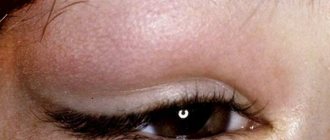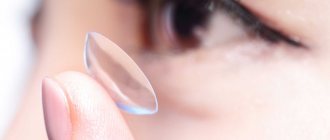At high temperatures, which accompanies most colds, eye pain often occurs. As a rule, pressing or pulsating, but not sharp. What is the reason for this and what remedies can alleviate this condition?
Pain in the eyes occurs not only with a cold or flu, but also with other diseases, the course of which is accompanied by an increase in temperature. The sensations are similar to severe fatigue of the eye muscles: it is difficult to focus vision, the eyelids become heavy. Often this condition appears against the background of a headache.
The reason for discomfort in the eyes when the temperature rises is that there are a lot of nerve endings and blood vessels in the eyeball. When an infection enters the body and the immune system begins to fight it, blood flow and metabolism accelerate, and the load on the vessels increases. Sometimes this can lead to painful sensations. This is not dangerous for the health of the visual system, but in combination with other symptoms it further worsens the general condition of the body.
Causes and manifestations
All causes of eye pain with fever can be divided into several main groups:
- infections;
- non-infectious inflammations;
- consequences of injuries;
- allergy.
Diseases are also divided into local or general.
Eye diseases
Most often, the eyes hurt with an increase in temperature due to infectious pathologies. The temperature reaction is observed mainly in children; an adult tolerates such diseases more easily.
- Bacterial or viral conjunctivitis. The most common pathology that develops due to infection on the mucous membrane. Accompanied by redness of the mucous membrane, lacrimation, a feeling of sand, and a strong burning sensation. The temperature rises no more than 37*C.
- Keratitis. Damage to the cornea is often caused by a herpetic infection. The eyes hurt quite badly, and blistering rashes appear on the eyelids. The temperature rises to 38-38.5*C, but quickly returns to normal. Characterized by blurred vision.
- Uveitis. This is an inflammation of the choroid, usually of parasitic or traumatic origin. Accompanied by bursting pain and a moderate temperature reaction.
- Blepharitis. Inflammation of the edges of the eyelids is accompanied by severe pain and itching. The temperature rises slightly.
In children, eye diseases are more severe and last longer.
General diseases
If a person has a headache and eye pain at the same time, and the temperature rises, these are signs of a respiratory infection. Symptoms develop gradually, with malaise and irritability.
Why the eyes hurt at high temperatures is explained by their pronounced blood supply. The eyeballs contain a large number of blood vessels. When the blood heats up, the blood vessels expand, causing pain.
With ARVI, intoxication is less pronounced; the person’s eyeballs do not hurt so much as they are bothered by a runny nose along with a cough. With the flu, on the contrary, the runny nose is scanty, there is a severe headache, body aches, and photophobia. The conjunctiva turns red and swells.
Sinus problems
Sinuses are a common problem for many of us.
Is it an excess of mucus and even blood, which is in the same mucus... In addition, problems with the sinuses can manifest themselves in such phenomena as nasal congestion, headache (eyes often hurt), fever (in connection with this weakness appears) and etc. These difficulties are mainly caused by inflammation or a viral infection that blocks the nasal cavity (congestion), causing uncomfortable pain. In such cases, the body needs to do something about the disease, the most important condition for which is strong immunity, allowing the body to fight the infection as much as possible.
Causes of eye pain at fever
Conjunctivitis, keratitis, iridocyclitis
The mucous membrane of the eye, and sometimes the cornea, becomes inflamed, lacrimation appears, fear of bright light appears, the eyelids swell, the eyes fester and become covered with crusts . pain, pain, burning in the eyes . Causes: bacteria, fungi, viruses.
Acute respiratory disease
With acute respiratory infections, acute respiratory viral infections, in addition to headaches and high fever, there is often pain in the eyes, lacrimation, and general weakness . This is a reaction of the eye mucosa weakened by the virus to inflammation. Painful sensations in the eyes weaken as you recover.
Sinusitis, sinusitis, frontal sinusitis
They usually occur as a complication after suffering from the flu or a cold. Fluid from the paranasal sinuses is unable to escape due to swelling of the mucous membrane. As a result of the infectious-inflammatory process, the accumulating exudate puts pressure on the walls of the sinuses, which causes bursting pain in the eyes, as well as in the forehead and cheeks . The pathology may be accompanied by fever, often subfebrile .
Encephalitis, meningitis
Bacterial or viral lesions of the central nervous system are characterized by headache, high fever, photophobia and painful sensations in the eyes . The symptoms are extremely similar to influenza, which complicates the timely diagnosis of the disease.
Important! Non-infectious pathologies can also cause eye pain and fever.
Connective tissue diseases
Connective tissue diseases often affect the vessels supplying the eye. Hence - pain in the eyes, decreased vision, spots before the eyes . An illness, for example, periarteritis nodosa, can occur against a background of elevated body temperature
Fever accompanying allergic reactions is considered not a typical symptom. However, temperature, especially low-grade fever, up to 37.50C is one of the manifestations of allergies, especially hay fever, food and drug intolerance. Itching, lacrimation, foreign body sensation and pain in the eyes complete the picture.
Inflammation of the sinuses - what is it?
Inflammation of the sinuses, which are located near the nose, is technically called sinusitis. These sinuses are actually spaces near the nose that expand towards the cheekbones and eyebrows. These areas are lined with mucous membranes and canals. And thus they are connected to the nose. If these channels are blocked (congested), the flow of air and natural secretions also stops.
As a result of inflammation, the temperature rises, which in turn causes weakness and fatigue.
What to do if symptoms appear
First of all, you need to consult with a specialist .
In cases where it is not possible to immediately visit an ophthalmologist, you can try to relieve inflammation on your own . To do this you should use:
- antihistamines;
- antipyretics;
- antiseptic eye drops.
Traditional medicine offers many recipes for eye washes that soothe and relieve inflammation :
- infusions of chamomile, yarrow, tea leaves;
- juice (diluted!) dill, aloe;
- decoctions of tea rose petals, bay leaves, rose hips and much more.
Photo 2: Do not delay visiting a doctor: if eye inflammation is not treated, irreversible changes in the cornea and mucous membrane can occur, including the development of blindness. Source: flickr (Irina Eremenko).
Why does nasal pain and stuffiness occur?
Meningitis
As mentioned, pain occurs when sinus inflammation flares up. Inflammation is caused by a viral infection, which can be a consequence of cold, drafts or hypothermia. It can also break out as a result of an infection in the throat or nose. Pathogenic microbes are constantly present in the mucous membranes, but make themselves felt in a situation of weakened immunity, after which they begin to multiply sharply. In addition to these reasons, inflammation can also occur due to irritation of the nasal passages.
Homeopathic medicines
One of the safest and most reliable methods of treating eye pain accompanied by fever is homeopathic remedies . But for therapy to be truly effective, it is necessary to take into account not only the external symptoms of the disease, but also the person’s psychotype. It is taking into account the individual characteristics of the patient that the homeopathic doctor prescribes certain medications.
To relieve symptoms of diseases at home, you can use the following symptomatic homeopathic remedies.
Diagnostics
To prescribe effective therapy, first of all, it is necessary to conduct a comprehensive examination of the patient in order to determine the etiology of pain in the head and a feeling of pressure in the eyes. Primary diagnostic measures include:
- Ultrasound of the vascular system (Dopplerography) of the brain.
- X-ray of the brain.
- Ophthalmoscopy.
- Clinical minimum (urine, blood, stool tests).
- Computed tomography (CT).
- Magnetic resonance imaging (MRI).
- ECHO-encephalography.
Treatment
If you experience an increase in temperature and pain in the eyes, it is recommended to consult a doctor. He will determine the cause of the condition and prescribe appropriate treatment.
For eye diseases, drops or ointments are prescribed:
- antibacterial - “Uniflox”, “Normax”, “Oftocipro”;
- antiviral - “Ophthalmoferon”, “Poludan”;
- healing - “Korneregel”, “Solcoseryl”.
For colds, bed rest and the prescription of antiviral drugs - Arbidol, Ingavirin - are indicated. If children have a high fever and their eyes hurt, they are given cool compresses on their foreheads and rubbed with a vinegar solution.
If there is no effect, antipyretics are prescribed - Nurofen, Panadol. The child is under the supervision of a doctor throughout the illness.
You can also watch an interesting episode of a program about health on the topic of which product should be excluded from the diet during ARVI, flu and colds.
When a person’s eyes hurt, his temperature rises, and he feels unwell—these are signs of illness. A therapist or ophthalmologist will help determine the diagnosis. It is not recommended to delay visiting a doctor; this increases the risk of complications.
Cold
The symptoms of flu, colds and sore throats are very similar. However, they have their own distinctive features.
Sore throat usually occurs in childhood. As a rule, the disease is caused by streptococci and other bacteria and viruses. Viral tonsillitis (tonsillitis) goes away within a week without treatment. Bacterial inflammation is a serious condition that requires treatment to prevent damage to other organs.
Symptoms
- Sudden, increasing pain in the throat when swallowing - may radiate to the ear or eyes.
- High fever, headache and vomiting.
- Swollen lymph nodes in the neck.
Strep throat is usually treated with penicillin or other antibiotics for about 10 days. Paracetamol is also suitable for reducing fever if you have a headache or a sore throat (recommended because children cannot be given Aspirin because it can cause Reye's syndrome, a rare disease that damages the liver and brain).
Influenza is one of the most common infectious diseases. Every year, 10% of the world's population is infected, and during a pandemic this number can even reach 40-50%.
Flu symptoms
The onset of the disease occurs very quickly. In the morning a person may feel good, but in the evening his whole body hurts. In the case of influenza without complications, symptoms are most evident during the first 3-5 days. They then gradually subside, but some of them, such as fatigue and weakness, can persist for up to 2 weeks.
The following symptoms indicate influenza:
- The throat hurts severely, especially when swallowing, sometimes the pain radiates to the ears and eyes.
- Enlarged lymph nodes in the neck.
- Heat.
- Headache.
- “The whole body” hurts.
- Sometimes nasal congestion may be present.
Treatment of influenza involves bed rest and adequate fluid intake, as well as taking antiviral medications. If nasal congestion is present, a nasal spray (ideally with sea water, which moisturizes the mucous membrane) will help. Otherwise, the flu can lead to other serious illnesses and complications caused by either a virus or a bacterial infection. The most common complications are pneumonia, bronchitis and inflammation of the middle ear. A rare complication is inflammation of the heart muscle.
The average person meets her on average once a year. In particular, the disease occurs most often in children, visiting them about 5-10 times a year. In this disease, a weakened body encounters an infectious pathogen - a virus or bacteria that affects the upper respiratory tract. The disease often occurs after hypothermia.
Cold symptoms
The first symptoms usually begin to appear within a few hours to 2 days after infection:
- Sneezing, coughing, runny nose, lacrimation.
- Sore throat, hoarseness.
- Pain in the muscles or throughout the body.
- Feeling tired, unwell.
It is recommended to use medications that relieve symptoms of the disease, such as headaches, sore throat, nasal congestion, and cough. If we are talking about bacterial inflammation, antibiotics are prescribed. Sometimes a bacterial infection is added to a cold, especially if the disease is not treated;











